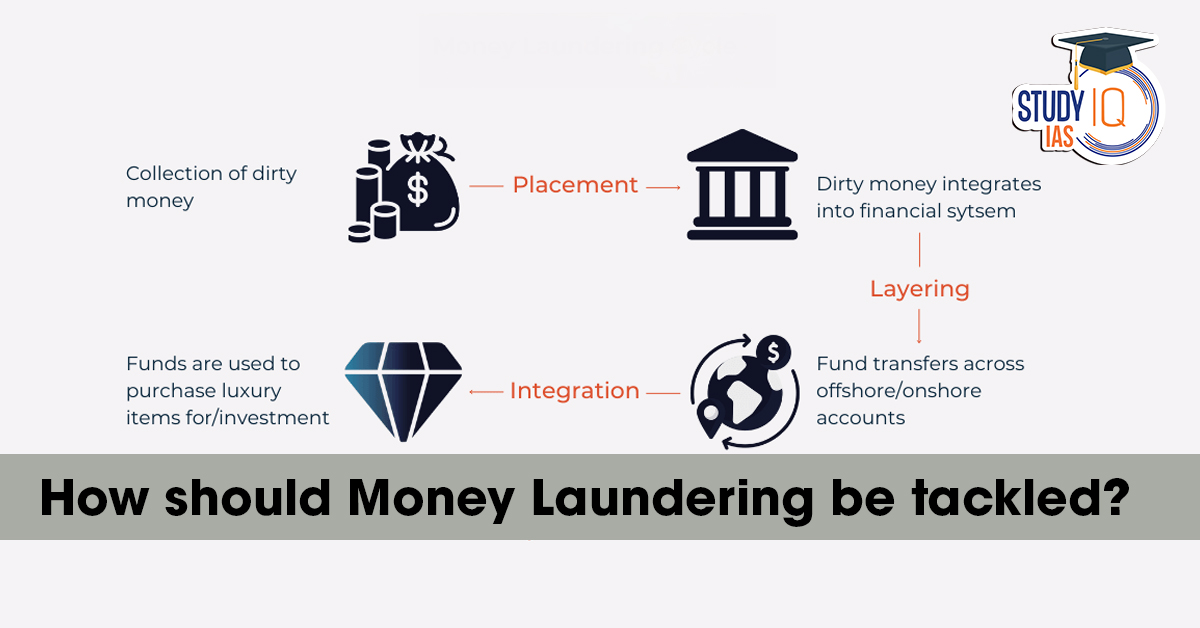Table of Contents
Context: A report in the Rajya Sabha says that since 2015, the Enforcement Directorate (ED) has taken up 5,892 cases under the Prevention of Money Laundering Act (PMLA), 2002, but only 15 cases have led to conviction so far.
What does it imply?
This shows two main problems:
- Very few convictions despite many investigations.
- A rising number of money laundering cases means the law is not stopping such crimes effectively.
What is a Laundromat?
A laundromat is a system that cleans dirty money, turning money earned through crime into legal-looking money.
- The term came from actual laundromats used by US crime groups as a front for illegal money.
- Laundromats can be banks, finance companies, or shell firms used to hide money, avoid taxes, or move it abroad.
- They help in laundering crime money, hiding asset ownership, and breaking currency laws.
How is Money Laundered?
- According to Section 3 of PMLA, money laundering means converting money earned through crime to make it look legal.
- It happens in three stages:
- Placement: Inserting the dirty money into the financial system. For example, breaking big amounts into smaller chunks (called smurfing) to avoid suspicion.
- Layering: Moving the money through multiple accounts or investments to hide its source.
- Integration: Using the cleaned money to buy property, businesses, or assets.
The Supreme Court in P. Chidambaram vs ED (2019) said that hiding illegal money hurts India’s financial system, national security, and can cause inflation.
What is Prevention of Money Laundering Act (PMLA)?
- In line with the UN Political Declaration and Global Programme of Action (adopted by the UN General Assembly in February 1990), the Prevention of Money Laundering Act (2002) was made to:
- Prevent laundering of money, and
- Confiscate illegal property.
Key Features
- The burden of proof lies on the accused, not the government.
- ECIR (Enforcement Case Information Report) is enough to begin an investigation. FIR is not needed.
- A scheduled offence (like corruption, fraud, or drug trade) is needed to define an act as money laundering.
Problems in Implementation
- Rising Cases, Fewer Convictions: Cases are increasing, but very few end in punishment.
- This questions how well the law is being applied.
- Possible Misuse of Law: The law has sometimes been used for political targeting.
- Eg., In Vijay Madanlal Chaudhary vs Union of India (2022), the court said property can be attached even if there’s no registered criminal case. This has led to abuse of power in some cases.
Way Forward
- Better Implementation: Investigating agencies must follow the FATF (Financial Action Task Force)
- Investigations should be fair, careful, and evidence-based, not politically driven.
- Stop Misuse, Improve Convictions: Law must be used to target real crimes, not opposition leaders.
- This will help improve the conviction rate and restore public trust.
- International Support: India has signed Double Taxation Avoidance Agreements (DTAAs) with 85 countries.
- These help in sharing financial and tax information, making it harder to hide black money abroad.


 Out-of-Pocket Health Expenditure, Reason...
Out-of-Pocket Health Expenditure, Reason...
 Treasury Bills (T-bills): RBI Cuts Holdi...
Treasury Bills (T-bills): RBI Cuts Holdi...
 Fisheries Sector in India, Current Statu...
Fisheries Sector in India, Current Statu...

























